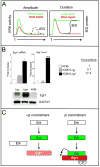Towards a molecular understanding of the differential signals regulating alphabeta/gammadelta T lineage choice
- PMID: 20471282
- PMCID: PMC2906684
- DOI: 10.1016/j.smim.2010.04.008
Towards a molecular understanding of the differential signals regulating alphabeta/gammadelta T lineage choice
Abstract
While insights into the molecular processes that specify adoption of the alphabeta and gammadelta fates are beginning to emerge, the basis for control of specification remains highly controversial. This review highlights the current models attempting to explain T lineage commitment. Recent observations support the hypothesis that the T cell receptor (TCR) provides instructive cues through differences in TCR signaling intensity and/or longevity. Accordingly, we review evidence addressing the importance of differences in signal strength/longevity, how signals differing in intensity/longevity may be generated, and finally how such signals modulate the activity of downstream effectors to promote the opposing developmental fates.
2010 Elsevier Ltd. All rights reserved.
Figures



Similar articles
-
gammadelta and alphabeta T cell lineage choice: resolution by a stronger sense of being.Semin Immunol. 2010 Aug;22(4):228-36. doi: 10.1016/j.smim.2010.04.005. Epub 2010 May 13. Semin Immunol. 2010. PMID: 20466561 Review.
-
Disorderly conduct in gammadelta versus alphabeta T cell lineage commitment.Semin Immunol. 2010 Aug;22(4):222-7. doi: 10.1016/j.smim.2010.04.003. Epub 2010 May 6. Semin Immunol. 2010. PMID: 20451409 Free PMC article. Review.
-
Beyond alphabeta/gammadelta lineage commitment: TCR signal strength regulates gammadelta T cell maturation and effector fate.Semin Immunol. 2010 Aug;22(4):247-51. doi: 10.1016/j.smim.2010.04.006. Epub 2010 May 8. Semin Immunol. 2010. PMID: 20452783 Free PMC article. Review.
-
αβ versus γδ fate choice: counting the T-cell lineages at the branch point.Immunol Rev. 2010 Nov;238(1):169-81. doi: 10.1111/j.1600-065X.2010.00947.x. Immunol Rev. 2010. PMID: 20969592 Free PMC article. Review.
-
Recent insights into the signals that control alphabeta/gammadelta-lineage fate.Immunol Rev. 2006 Feb;209:176-90. doi: 10.1111/j.0105-2896.2006.00349.x. Immunol Rev. 2006. PMID: 16448543 Review.
Cited by
-
Development of γδ T Cells: Soldiers on the Front Lines of Immune Battles.Methods Mol Biol. 2023;2580:71-88. doi: 10.1007/978-1-0716-2740-2_4. Methods Mol Biol. 2023. PMID: 36374451
-
The TCR ligand-inducible expression of CD73 marks γδ lineage commitment and a metastable intermediate in effector specification.J Exp Med. 2014 Feb 10;211(2):329-43. doi: 10.1084/jem.20131540. Epub 2014 Feb 3. J Exp Med. 2014. PMID: 24493796 Free PMC article.
-
In vivo fate mapping identifies pre-TCRα expression as an intra- and extrathymic, but not prethymic, marker of T lymphopoiesis.J Exp Med. 2013 Apr 8;210(4):699-714. doi: 10.1084/jem.20122609. Epub 2013 Mar 18. J Exp Med. 2013. PMID: 23509324 Free PMC article.
-
Nodal EBV+ cytotoxic T-cell lymphoma: A literature review based on the 2017 WHO classification.J Clin Exp Hematop. 2020;60(2):30-36. doi: 10.3960/jslrt.20001. J Clin Exp Hematop. 2020. PMID: 32565530 Free PMC article. Review.
-
Rpl22 Loss Selectively Impairs αβ T Cell Development by Dysregulating Endoplasmic Reticulum Stress Signaling.J Immunol. 2016 Sep 15;197(6):2280-9. doi: 10.4049/jimmunol.1600815. Epub 2016 Aug 3. J Immunol. 2016. PMID: 27489283 Free PMC article.
References
-
- Hayday AC. [gamma][delta] cells: a right time and a right place for a conserved third way of protection. Annu Rev Immunol. 2000;18:975–1026. - PubMed
-
- Carding SR, Egan PJ. Gammadelta T cells: functional plasticity and heterogeneity. Nat Rev Immunol. 2002;2:336–45. - PubMed
-
- Salerno A, Dieli F. Role of gamma delta T lymphocytes in immune response in humans and mice. Critical Reviews in Immunology. 1998;18:327–57. - PubMed
-
- King DP, Hyde DM, Jackson KA, Novosad DM, Ellis TN, Putney L, et al. Cutting edge: protective response to pulmonary injury requires gamma delta T lymphocytes. Journal of Immunology. 1999;162:5033–6. - PubMed
-
- Girardi M, Oppenheim DE, Steele CR, Lewis JM, Glusac E, Filler R, et al. Regulation of Cutaneous Malignancy by {gamma}{delta} T Cells. Science. 2001;20:20. - PubMed
Publication types
MeSH terms
Substances
Grants and funding
LinkOut - more resources
Full Text Sources

